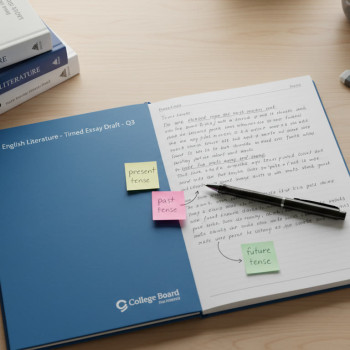Why This Plan Exists (And Why It Works)
Let’s be honest: not every AP student has the budget or availability for weekly private tutoring. That doesn’t mean you can’t get an excellent score. It means you need a smarter, leaner plan. This guide shows you how to combine peer support, freely available high-quality materials, focused practice, and occasional targeted help (for example, Sparkl’s personalized tutoring and AI-driven insights when you need them) into a single sustainable system.
Think of this as an academic lean-startup: iterate fast, measure what helps, scale the small wins. The result is a confident AP student who maximizes limited resources without burning out.
Core Principles: What Makes Limited-Tutoring Plans Successful
1. High-Leverage Activities First
Not all study is created equal. Focus on activities that give the biggest score improvement per hour: targeted practice on exam-style questions, error analysis, and understanding the rubric (for free-response sections). Passive rereading or highlighting belongs lower on the list.
2. Active, Social Learning Beats Solo Cramming
Peer study groups, teaching a concept to someone else, and collaborative problem-solving force retrieval and explanation — two things the brain loves. Use affordable or free group time to simulate tutoring by turning peers into teaching partners.
3. Consistency Over Intensity
Short, regular sessions beat occasional marathons. Twenty focused minutes daily often trumps a single six-hour weekend cram. The spacing effect and interleaving topics improve retention and transfer — exactly what AP exams test.
Build Your Ecosystem: Tools and Resources
You don’t need expensive subscriptions to build an excellent AP prep toolkit. Mix official College Board materials with curated open resources and community tools. Below is a practical mix you can assemble in a few hours.
Essential Items
- College Board Course and Exam Description (CED) for your AP subject — the syllabus of the exam.
- Official practice questions and released exams from the College Board where available.
- AP Classroom (if your teacher provides access) — short videos and topic questions.
- One well-organized review book (physical or digital) that you actually use — not a shelf of unopened guides.
- Free online lessons and practice via reputable sources: university lecture notes, educational channels, and open textbooks aligned with the AP framework.
Community and Peer Tools
- Weekly peer study group (virtual or in-person) with rotating roles: facilitator, problem-writer, explain-to-all, and timed-practice leader.
- A shared folder or simple learning management folder (Google Drive, OneDrive) with organized topic folders and a set of go-to problems.
- Discord, Slack, or GroupMe for quick Q&A and micro-explanations between sessions.

60-Day Action Plan: From Panic to Prepared
This is a practical, day-by-day approach for the last two months before the AP exam. It assumes limited tutoring (1–3 targeted sessions maximum) and heavy reliance on peers and open resources, with the option to insert one or two Sparkl personalized tutoring sessions for tricky topics or feedback on written responses.
Phase 1 — Days 1–7: Diagnose and Prioritize
- Take a timed diagnostic — one full practice section or a released exam if available.
- Use the diagnostic to identify 3–5 high-priority weaknesses (e.g., pacing, specific content topics, free-response structuring).
- Create a simple tracker: topic, current confidence (1–5), and practice items to address it.
- If you can schedule a Sparkl tutor session, book one now focused on interpreting your diagnostic and building a two-week plan; if not, get feedback from a teacher or top-performing peer.
Phase 2 — Days 8–28: Targeted Practice & Peer Teaching
- Daily 30–60 minute sessions focusing on one topic per day — start with your weakest areas. Use active practice: 15 minutes of question work, 10 minutes of error analysis, 5–10 minutes of summary or teach-back.
- Weekly peer sessions (60–90 minutes): rotate who prepares problems and who teaches; end with a timed 25–40 minute mini-test.
- For free-response practice, write one response every 3–4 days and swap with a peer for feedback using a rubric checklist derived from the College Board’s scoring guidelines.
Phase 3 — Days 29–45: Mixed Practice and Timing
- Begin interleaving topics — mix questions from different units in a single session to improve transfer.
- Practice full sections under timed conditions once per week, focusing on pacing techniques and exam mechanics (how to use digital Bluebook tools if your exam is digital).
- Schedule one targeted tutoring session (optional) for persistent weaknesses, especially for scoring on written responses where expert feedback yields quick gains — Sparkl’s 1-on-1 guidance can be especially helpful here.
Phase 4 — Days 46–60: Full-Length Simulations and Fine-Tuning
- Do two full-length practice exams (one every week) under exam-like conditions. After each, perform a structured review: score, analyze errors by category, and update your tracker.
- Polish exam strategy: time allocation per section, when to guess, and how to structure essays/constructed responses quickly.
- Lighten load in the final week: short active practice, targeted review of formula sheets/concept maps, solid sleep schedule, and mindset preparation.
Efficient Weekly Template (When You Have Little Time)
Use this template when school commitments leave only a few hours a week for AP prep.
| Day | Activity | Duration | Goal |
|---|---|---|---|
| Mon | Targeted practice (weakest topic) | 30–45 min | Fix one recurring error |
| Wed | Peer session: teach & test | 60–75 min | Explain concepts and simulate Q&A |
| Fri | Mixed practice (interleaved questions) | 30–45 min | Improve transfer and memory |
| Sun | Timed section or free-response practice | 45–90 min | Build stamina and pacing |
How to Run a High-Impact Peer Study Session
Peer groups are a force multiplier when organized. Keep the group small (3–5 students) and assign roles to avoid the classic “discussion wanders” trap.
- Warm-up (5–10 min): quick flash questions or one mini multiple-choice quiz.
- Teach-back (20–25 min): one person explains a concept while others take notes and ask clarifying questions.
- Practice Block (20–30 min): work through 6–8 mixed problems in pairs, then rotate and review answers together.
- Reflection and Next Steps (5–10 min): each person names one improvement and one practice item for the next meeting.
Using Open Resources Well
Open or freely available resources are great — but they become excellent when curated. Here’s how to get the most from them.
- Match resources to the CED: always cross-reference any lesson or practice item to the skills and topics listed in the College Board course framework.
- Prioritize source quality: brief university lecture notes, official released questions, and reputable educational channels are usually better than random blog posts.
- Create a short playlist or reading list for each unit so your peer group knows exactly which page or video to prepare before a session.

Free-Response Mastery Without Full-Time Tutoring
Free-response questions (FRQs) are where focused feedback pays off most. With limited tutoring, leverage peers and a small number of expert reviews strategically.
- Write often, but short: practice organizing responses into quick outlines before writing the full answer. Time-box the outline to 3–4 minutes.
- Use rubrics: convert the rubric language into a 3–5 bullet checklist you can mentally run through while writing.
- Peer swap with structured feedback: each reviewer must identify one strong element and one fix, tied to rubric points.
- Once every 2–3 weeks, send one FRQ to an expert for a focused review — smaller, high-quality feedback sessions are more impactful than long, infrequent lessons. If you choose to use occasional professional help, Sparkl’s 1-on-1 guidance can be used exactly this way: targeted reviews and tailored study plans that fit limited budgets and schedules.
Tracking Progress Simply and Effectively
Your progress tracker should be readable at a glance. Use a single spreadsheet with these columns:
- Topic
- Target Skill (e.g., ‘Integration by Parts’ or ‘Thesis Development’)
- Practice Items Completed
- Confidence (1–5)
- Next Action
Update weekly. Re-prioritize topics with low confidence but high frequency on the exam.
When to Invest in Targeted Tutoring
Even with a strong peer/open-resource plan, certain bottlenecks deserve expert help. Consider a short, sharp tutoring investment if:
- Your diagnostic shows a systematic gap that peers can’t explain (e.g., a calculus concept or syntactical issue in language exams).
- You’re aiming for a top score and need fine-grained rubric-level feedback on written responses or projects.
- You’ve plateaued despite consistent effort — an expert can often find one tweak that unlocks a big improvement.
Sparkl’s personalized tutoring can be booked for a handful of sessions targeted at those exact needs: one-on-one guidance, tailored study plans, and AI-driven insights to identify your highest-return practices.
Mindset, Test Day, and Final Week Tips
Mindset
Confidence is a skill. Practice under realistic conditions to desensitize exam anxiety. Use small breathing techniques and familiarity with exam mechanics to reduce mistakes born of stress.
Final Week
- Shift from learning to consolidation. Review your short summaries, formula sheets, and the 10–15 highest-yield problems.
- Prioritize sleep, hydration, and steady meals — cognitive performance is fragile the last few days.
- Do one light timed section 3–4 days before the exam, then taper practice. The day before, do low-effort review and relaxation.
Examples: Two Realistic Student Scenarios
Case A — Maria: AP Biology, Limited Budget, Ambitious Score
Maria forms a trio with two classmates. They meet twice weekly for 75 minutes, rotate who teaches, and compile shared photo notes of diagrams. Every two weeks they submit one free-response to their AP teacher for feedback. Maria schedules two Sparkl sessions before the exams: one to tighten experiment interpretation answers and one to practice lab-based FRQs. Result: targeted improvements in high-yield areas without a full tutoring schedule.
Case B — Ethan: AP Calculus AB, Busy with Sports
Ethan uses short daily practice blocks on his phone during commute times, joins a weekly 50-minute study huddle, and completes weekly timed sections on Saturday mornings. He uses an open lecture series for weak topics and books three expert tutoring sessions across two months for pacing and FRQ structure. He attributes most gains to consistent mixed practice and the clarity gained from the targeted expert sessions.
Common Pitfalls and How to Avoid Them
- Pitfall: Rereading without self-testing. Fix: Convert notes into quick quizzes or flashcards and always self-test before reviewing answers.
- Pitfall: Endless content breadth without depth. Fix: Prioritize 20% of topics that historically yield 80% of the typical exam’s tested skills for your subject.
- Pitfall: Passive peer sessions. Fix: Enforce roles and outputs — each meeting must produce one corrected problem set and one actionable next step.
Final Thought: Make the Plan Your Own
Limited tutoring doesn’t mean limited potential. With a focused, social, and resource-smart approach — and the option to add a few high-quality expert sessions like Sparkl’s when it truly matters — you can build momentum, master the critical skills, and arrive at test day ready.
Start with a diagnostic, build a compact 60-day plan, and iterate weekly. Keep it social, keep it active, and keep a small but precise budget for expert help when your progress stalls. That’s the winning formula: smart resources, strong peers, and precise tutoring when it counts.
Ready to Try It?
Pick one topic today, set a 20-minute timer, and do targeted practice. Share your results with a peer and plan your next session — momentum starts with one small action.




















No Comments
Leave a comment Cancel